I was kind of sad to leave our room. We developed a routine that was comfortable and entertaining. But check-out we did. We stowed our gear with the porter and took a short walk to the National Museum of the American Indian. Hardly anyone was there, although there were tons of busses of schoolchildren parked over the holiday weekend.
The museum opened in 2004, so it’s relatively new. It was built to be “a living memorial to Native Americans and their traditions.” But if you’re looking for exhibits of pottery and bows and arrows, clothing and history of the tribes, how and where they lived, religious beliefs or customs, you’ll be out of luck.
What I didn’t learn at this museum: American Indians were basically farmers without any concept of land ownership. They farmed an area for 50-100 years until the soil was depleted. At that point, the tribe would pick up and move to a new location. If other Indians already lived there, battle commenced and to the winner went the spoils.
They were expert hunters, gatherers and fishermen. I can’t recommend the book Mayflower highly enough. It gives great insight into the complex relationship between the native population and the newcomers.
I guess I am spoiled by visits to the Southwest Museum in Los Angeles, where Indian artifacts are crammed into every niche. Aside from a few modest displays near the elevators, this museum was filled with information (few artifacts) about broken treaties and wars. That’s kind of like making the American History Museum a war museum only. I was really disappointed.
Further, the museum is not without controversy. It was discovered the Smithsonian held between 12-18,000 Indian remains, mostly in storage. Although repatriation of human remains, funerary, sacred and illegally acquired objects are being considered for return to tribal communities, only about 5,000 individual remains have been repatriated to date.

Display of carved animals

Children’s clothing and toys above and below


There was a small but interesting display about Code talkers. I knew about them in WWII but they actually started in WWI.
We found an interesting explanation of the Day of the Dead in the gift shop, of all places.
“The tradition of Dia de los Muertos or Day of the Dead grew out of a combination of Indian beliefs and European Christianity. The Day of the Dead is celebrated in Mexico on November 1st and 2nd every year. The Mexican people believe the gates of heaven are opened at midnight on October 31st and for 24 hours Angelitos—the spirits of deceased children—are allowed to rejoin their families. The modern celebration, which is very expensive for many indigenous villagers, involves making offerings of food, flowers, and other items at an altar in honor of a loved one who has died. Skeletons and skulls made of sugar, ceramics or papier-mâché provide final touches.”

I had to have this delightful ceramic tile of skeletons enjoying margaritas.
I didn’t get off to a good start at the museum either. For the first time ever, I set off the entry scanner. The girl who wanded me and checked my stuff treated me pretty much like a criminal. There was no thank you for your time or apology either. I wouldn’t recommend this experience to anybody.
Good news was, we finished up quickly and made our way to the airport at a leisurely pace.

We landed in Greenville, South Carolina before we knew it.

Great gasoline prices compared to California
All our activities caught up with me and I headed for bed early. Stay tuned for the next adventure in South Carolina!
